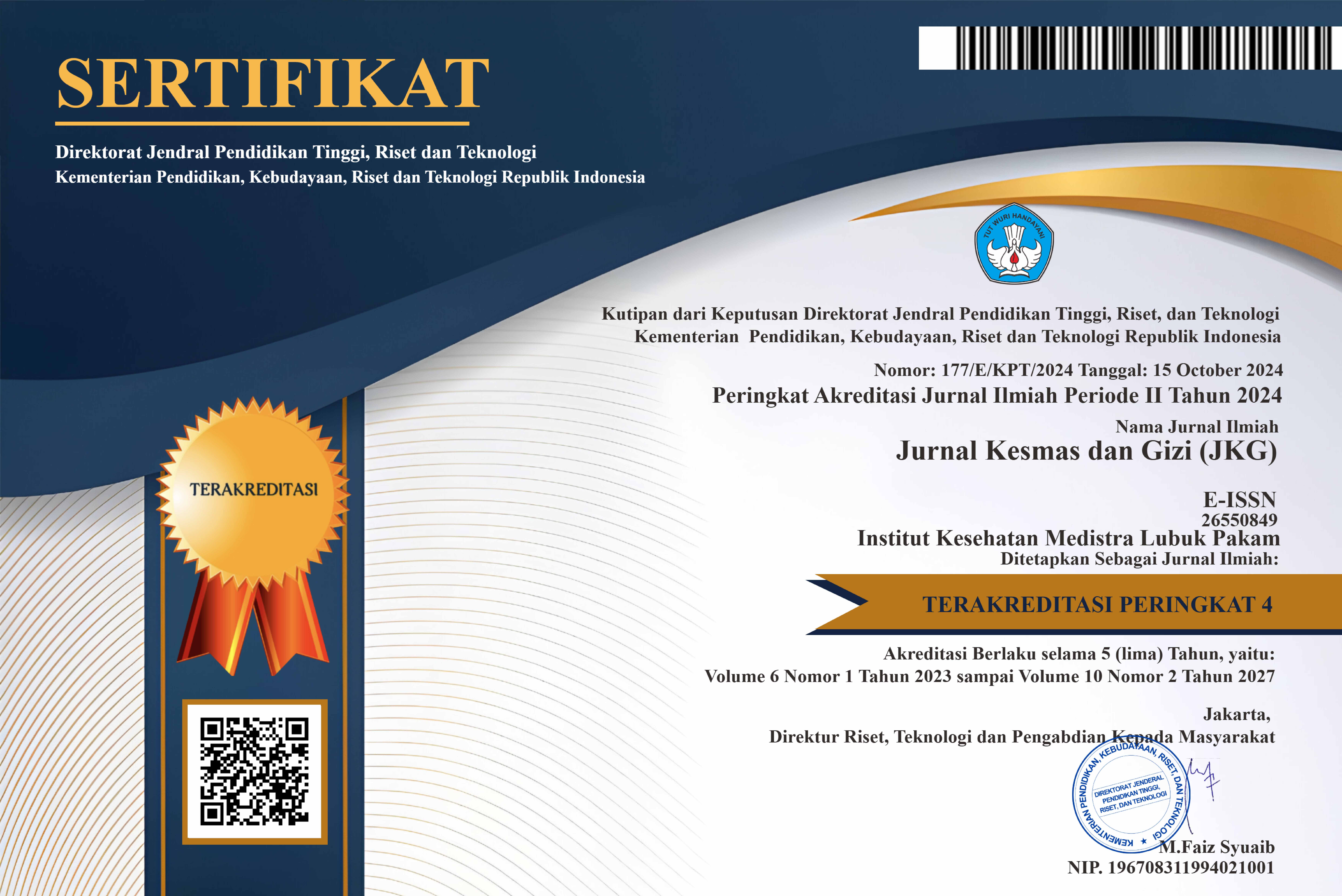Effect of Nebulization with Semi Fowler Position on Breath Frequency in Bronchial Asthma Patients in Grandmed Lubuk Pakam Hospital
DOI:
https://doi.org/10.35451/jkg.v6i2.2143Keywords:
Bronchial Asthma, Respiratory Frequency, Nebulization, Semi-FowlerAbstract
Bronchial asthma is a condition of chronic inflammation of the respiratory tract which triggers bronchial hyperactivity resulting in a feeling of heaviness in the chest and shortness of breath. Asthma patients panic easily by breathing as hard as possible when shallow and short inspirations occur. If asthma occurs for a long duration, apnea will occur and in the worst case it can result in death for the sufferer. Procedures via nebulization using the semi-Fowler position in patients with bronchial asthma can affect respiratory frequency. Nebulizer administration is a type of medication directly on targets such as the lungs so that this action can be carried out more quickly and effectively. The method in this research uses a quasi-experimental pre-test and post-test type by selecting bronchial asthma patients as respondents/sample of 15 participants who were determined using the total sampling method. Research data was collected using an observation sheet instrument containing data regarding respiratory frequency. After the intervention was given, the respondents showed that there was a decrease in respiratory frequency until it was at the normal threshold. Data analysis using a paired T-Test shows that the p-value is 0.000, which means that nebulization in the semi-Fowler position can affect the respiratory frequency of bronchial asthma patients at Grandmed Lubuk Pakam Hospital. It seems that administering nebulization in a semi-Fowler's position could be an appropriate choice in treating bronchial asthma patients in order to achieve better respiratory health.
Downloads
References
Waladani B. (2021). Efektifitas Pemberian Semi Fowler dan Fowler terhadap Perubahan Status Pernapasan pada Pasien Asma, 1–8.
Arifian L dan Kismanto J. 2018. Pengaruh Pemberian Posisi Semi Fowler Terhadap Respiration Rate Pada Pasien Asma Bronkial Di Puskesmas Air Upas Ketapang. Jurnal Kesehatan Kusuma Husada - Juli 2018. Vol. 9 No. 2.
Astuti WT, Marhamah E, Diniyah N. (2019). Penerapan Terapi Inhalasi Nebulizer Untuk Mengatasi Bersihan Jalan Napas Pada Pasien Broko pneumonia. Jurnal Keperawatan Karya Bhakti, Vol 5 No. 2 Juli 2019, p-ISSN : 2477 – 1414, Hal 8 – 13.
Erlien (2018) Penyakit Saluran Pernafasan. Jakarta Selatan: PT Sunda Kelapa Pustaka.
Manurung, N. (2019). Hubungan Fungsi Keluarga Bidang Kesehatan Terhadap Relaps Penderita Asma Bronkhiale Di Pantai Labu Deli Serdang. Jurnal Ilmiah Keperawatan Imelda,Vol. 5, No. 2, September 2019,e-ISSN 2597-7172, p-ISSN 2442-8108, Hal 101 – 105.
PDPI, 2014. Pneumonia Komuniti: Pedoman Diagnosis dan Penatalaksanaan di Indonesia. Edisi II. Jakarta: Perhimpunan Dokter Paru Indonesia
Sondakh SA, Onibala F, Nurmansyah M. (2020). Pengaruh Pemberian Nebulasi Terhadap Frekuensi Pernafasan Pada Pasien Gangguan Saluran Pernafasaan. Jurnal Keperawatan (JKp), Vol 8, No 1 Februari 2020, ISSN 2302-1152, Hal 75 – 82.
Sugiyono. 2015. Metode Penelitian Kuantitatif Kualitatif dan R&D. Bandung: Alfabeta.
Surastini RK. (2019). Gambaran Asuhan Keperawatan Pemberian Prosedur Nebulizer Untuk Mengatasi Bersihan Jalan Nafas Tidak Efektif Pada Anak Bronkopneumonia. Jurnal Keperawatan,Politeknik Kesehatan Denpasar. Hal 7 – 19.
Tafdhila, & Kurniawati, A. (2019). Pengaruh Latihan Batuk Efektif Pada Intervensi Nebulizer Terhadap Penurunan Frekuensi Pernafasan Pada Asma Di Instalasi Gawat Darurat. Babul Ilmi_Jurnal Ilmiah Multi Science Kesehatan, 11, 117–127.
World Health Organization. Chronic Respiratory Disease. 2017. http://www.who.int/respiratory/asthma/en/. World Health Organization (WHO). WHOQOL-Bref: Introduction, Administration, Scoring And Generic Version Of The Assesment (Field Trial Version). Ganeva: World Health Organization.
Downloads
Published
Issue
Section
License
Copyright (c) 2024 Anita Sri Gandaria Purba, Salbiah Siregar

This work is licensed under a Creative Commons Attribution 4.0 International License.
Copyright in each article is the property of the Author.


























